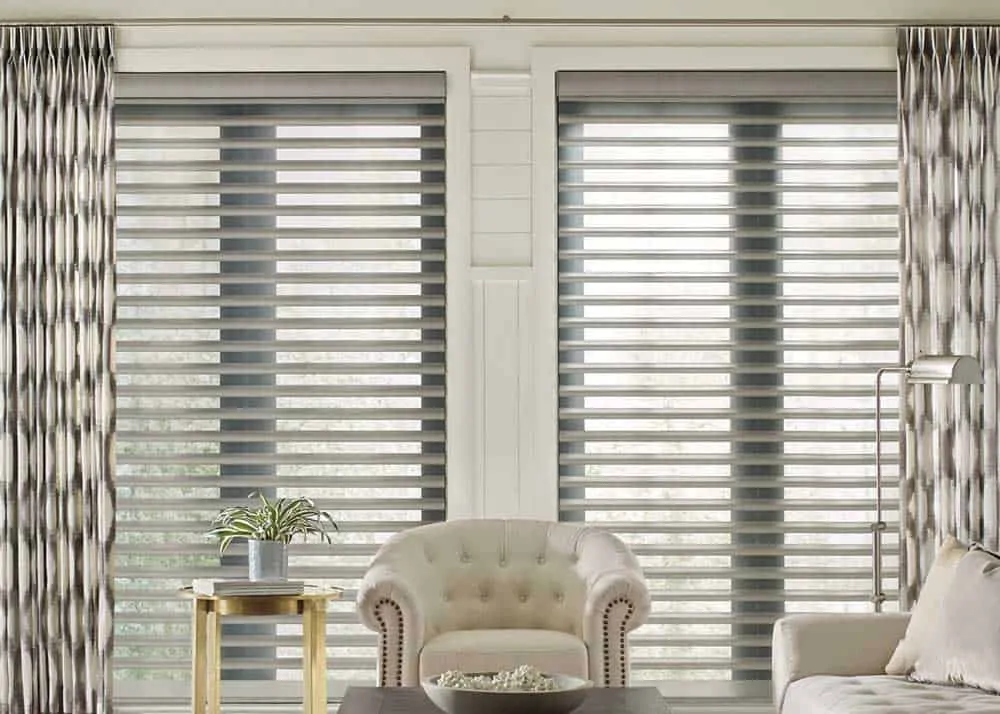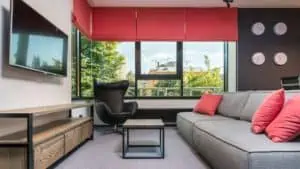Interior shutters, also called plantation shutters, are basically a bulkier version of blinds which are contained in frames that can open and close. They work well for smaller windows in kitchens and bathrooms, but are also popular as a mainstay fixture in an entryway or living room. Shutters can be paired with other window treatments or allowed to reside on their own.
In this post, we’re going to examine the art of styling interior shutters. We’ll talk about what shutters are made of, what they can pair with, and different types of shutters to consider.
What are Plantation Shutters?
Sometimes called interior shutters, plantation shutters are a kind of shutter that is placed on the inside of the window. Most plantation shutters have a single vertical rod which allows you to open and close the horizontal blades. Unlike blinds, shutters have a frame that nestles on the inside of the window to fit the frame of the window snugly. Shutters tend to allow a bit less light because they cannot be raised and lowered like traditional blinds. They can be paired with curtains, but shutters are generally left as a stand-alone window treatment.
What Are Shutters Made of?
There are a few different kinds of plantation or interior shutters. Vinyl plantation shutters are the cheapest variation. They usually have PVC or aluminum which can support their stability, and they have vinyl which is painted over the top. Vinyl shutters are the cheapest version, but they can also have structural issues especially if they are large or are exposed to a lot of heat or moisture.
Composite shutters use an engineered wood which is then wrapped in vinyl. The main advantage of composite shutters is that they bring the toughness of a wood shutter with the cheap pricing of a vinyl shutter. You’ll pay a bit more, but they are appropriate for bathrooms or kitchens that have moisture. The wood won’t warp in the same way that vinyl can.
If price is not an issue, wood shutters are by far the nicest. The authentic, natural colors pair excellently with a variety of rooms. They look great! Basswood interior shutters are the nicest kind that you’ll find, because the wood is lightweight and yet strong enough to make a solid shutter.
Pairing Shutters
Shutters look great on their own. And if you really want to install shutters, you’re almost always better off saving the money on curtains and buying a nicer version of the shutters you were considering. Darker wood shutters can bring a ton of definition to rooms that are painted in creams and lighter colors. Lighter wood shutters can soften rooms with darker, colorful walls.
Shutters and Curtains
But if you insist on pairing shutters with curtains, aim for floor-length curtains that drop past the shutters all the way to the floor. Keep the curtains at least a few inches above the shutter. Consider tying the curtains around the sides of the shutters to add a bit of layering.

Shutters and Valances
Valances can flow really well with shutters, as long as you match the valence to the rest of the room. For example, if you have a kitchen that is painted with a blue accent color, you’ll want a blue valance and perhaps a wood or white shutter. The valance will flow with the walls and room, while the white shutters will be allowed to pop.
Shutters and Shades?
The only treatment that you really can’t pair with shutters is a shade. Shades sit too close to the window to work with the shutter, which also drops over the front of the glass. The only exception is cafe shutters, which cover only the bottom half of the window. In special circumstances you could pair a nice, rich cafe shutter with a lighter roman shade. It would work well for sunrooms or reading rooms.
Types of Shutters to Consider
Solid Shutters
Some shutters don’t have openings in them at all! If you want the minimalism and definition of a shutter with the privacy and light-blocking of a blackout curtain, solid interior shutters are a great option. They are solid panes of vinyl or wood that cover the whole window, not allowing any light through. They don’t have individual panes which can be opened.
Solid shutters often take on solid, brighter colors. Patterns are quite rare. Darker colors tend to look odd when they are pressed into the wall, so keep the colors loose and vibrant.
Tiered Shutters (Tier on Tier)
Tier on tier, or full height shutters, are one of the more popular choices. They allow a good amount of light into the room but have two sections that can open and close independently. You can keep the bottom shutters closed but open up the top ones, which allows low visibility but high natural light. Narrow panels are usually folded into each other.
Full height interior shutters can take on almost any color scheme and look great. Darker colors give a rich, robust feeling of security to the room. Lighter, more whimsical colors like yellows and blues can give a room a charming, cafe like feeling.
Full Height Shutters
Like tiered shutters, full height interior shutters extend from the bottom to the top of the window. But unlike tiered shutters, they are not made from two separate pieces which are stacked on top of each other. Full height shutters look a bit more coherent and less piecemeal than the tiered design, but keep in mind that you’ll have less flexibility for the way that you open them.
Full height shutters are often made from darker woods or lighter colors that flow with the walls.
Cafe Style Shutters
Cafe style shutters cover only the bottom half of the window, while the top half is left exposed. Sometimes you can style the window with a Roman shade on top, but layering cafe style shutters is a difficult design to get right. Cafe style shutters are great for living rooms and back rooms that don’t face out into the street. Common colors are lighter whites, creams, and woods. Darker color shutters tend to look odd when they don’t fully cover the window.




